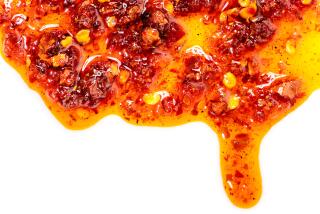Video tip: Homemade Sriracha-style hot sauce
Maybe it’s the sense of danger that reels you in at first. The crazy name, the wild picture slapped on the bottle. Before you know it, you’re in for the ride, and the best ones leave you reduced to a sweaty and speechless mess. When it’s finally over, you can’t help but want more.
I’m talking about hot sauce, a virtual thrill ride for the taste buds. And for fans, nothing beats the feeling.
So what makes hot sauce so attractive? Blame it on the capsaicin, the chemical behind a chile’s heat. When you eat hot sauce, or any chile-spiced foods, your mouth reacts to the capsaicin as if it’s in pain, signaling the brain. Your body responds by releasing endorphins, much like it does with laughter, chocolate, stress and sex.
RECIPE: Homemade Sriracha-style hot sauce
Pleasure and pain, conveniently packaged in a bottle. All I know is I can’t get enough of the stuff. I have a collection at home and drizzle at least one sauce -- more often two -- over everything. A sure sign of a junkie, lately I’ve even taken to making my own.
It’s amazingly simple. A puree of chiles and salt, thinned perhaps with vinegar or water, maybe a secret ingredient or blend of spices thrown in for good measure. Voila.
For a quick Sriracha-type sauce, take a pound of fresh red chiles -- red Fresnos and jalapenos can generally be found year-round — and mash them with fresh garlic and salt, a touch of sugar and vinegar. A little love on the stove top -- simmering the mash helps to marry the flavors -- then blend and strain the sauce, thinning as desired with water. The sauce literally comes together in minutes (as opposed to fermented hot sauces, which can take days, or more, to make). Though it tastes good right away, it gets even better after a day or two in the fridge.
CALIFORNIA COOKBOOK: Hundreds of terrific recipes
Play around with the sauce to personalize it to your tastes, changing up chiles and flavorings. And check out this recipe for a quick and easy-to-make Sriracha-style sauce.
A quick note on heat: Capsaicin is found in the inner ribs, or veins, of chiles, not just the seeds. To minimize the heat (why you’d ever want to do that, I don’t know), remove the ribs with the seeds. And when working with chiles, be careful. The capsaicin in the oils can burn your hands and eyes. Wear gloves when handling the hottest chiles, and work in a well-ventilated area.
Chile heat varies by type, with Anaheim and pasilla on the milder end and jalapenos and serranos packing somewhat more of a punch. Habaneros (or Scotch bonnets if you can find them) are legendary, and even naga jolokia (the ghost chile) is increasingly easier to find. For true hotheads, you can buy pure capsaicin by itself for a practically weapons-grade sauce.
Fresh green chiles are fine, though the flavor can be a little underripe and “grassy.” Ripe red chiles are the best, though they are generally seasonal, typically available from late summer through early fall.
Dried chiles, their flavor more concentrated and complex than fresh chiles, can be found year-round. To use them in a sauce, toast them briefly over a hot skillet to add smoky notes, then soak them in hot water to soften. Once softened, they can be used just like fresh chiles.
ALSO:
Go behind the scenes at the Test Kitchen
36 handy kitchen tips from the L.A. Times Test Kitchen
Browse hundreds of recipes from the L.A. Times Test Kitchen
More to Read
Eat your way across L.A.
Get our weekly Tasting Notes newsletter for reviews, news and more.
You may occasionally receive promotional content from the Los Angeles Times.











